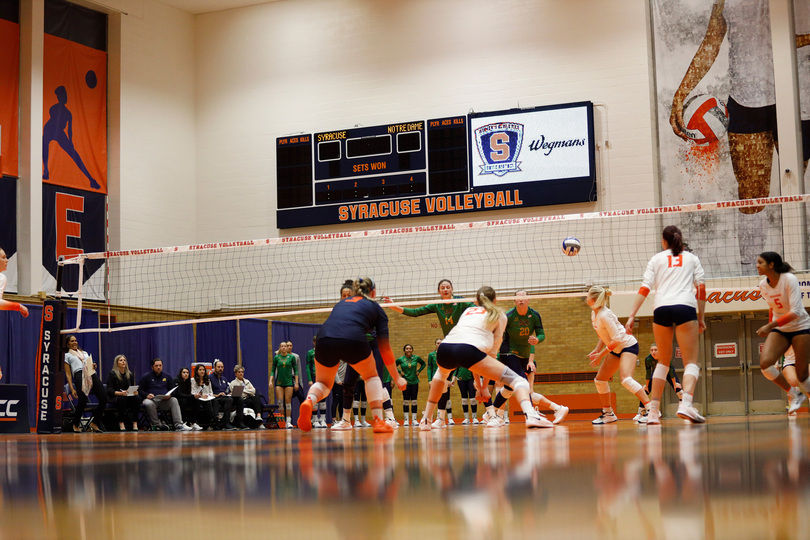Syracuse struggles to defend middle in straight sets loss to Notre Dame

Nick Luttrell | Contributing Photographer
Syracuse was unable to control the middle of the court as Notre Dame recorded 46 kills.
To support student journalism and the content you love, become a member of The Daily Orange today.
Alyssa Bert rose up and sent the ball low and hard over the net, only being dug out by Hattie Monson, who sent a cushioned ball to Avery Ross, firing it to the Syracuse side. Bert was the first to the ball, directing a pass over to Riley Hoffman who sent it along to Polina Shemanova, slamming it back over the net.
But again the Fighting Irish got a dig as Monson stuck out her right arm and popped the ball high into the air. Harmony Sample got under the ball, setting it for Paris Thompson, who lightly tapped it over the net. Bert laid out in the middle of the floor to try and save the point, but it fell just out of her reach.
The final point was emblematic of Syracuse’s (8-7, 4-1 Atlantic Coast) first conference loss of the season in straight sets to Notre Dame (6-9, 1-4 ACC). The Fighting Irish continually controlled the middle of the court, catching the Orange off guard numerous times.
“They attacked the open area well,” SU head coach Bakeer Ganesharatnam said. “We should have done a better job picking those balls up that landed in the middle.”
The Irish kept finding holes in Syracuse’s defense, especially during the first set where it found its most success. Five different times in the first set, Notre Dame set up as if one of their outside hitters was going to attempt a spike, but instead used their fingertips to tap the ball over.
Notre Dame’s Paris Thompson was often the player catching the Orange by surprise when she used her finesse to attack the middle. Thompson finished with a game high 20 kills. After a powerful serve by Raina Hughes was saved by Kaylen Winker, the sophomore once again found an opening in the Syracuse defense, directing the ball using a soft touch. Thompson’s kill gave Notre Dame a 24-20 lead in the first set, which it eventually went on to win.
Thompson, who came into the game with 29 kills on the season, almost doubled her season total against the Orange.
After noticing Notre Dame’s point of attack, Syracuse adjusted, making a concerted effort to protect the middle of the court aggressively in the second and third sets. During timeouts, SU went over what it needed to change tactically so it wouldn’t be hurt the same way.
“We make that adjustment and then like the whole point of the game is finding the holes,” Bert said. “Obviously then they are adjusting to finding the next hole to hit, so I think that it’s just a matter of making adjustments quicker.”
The Orange guarded the middle against Notre Dame more in the second half, with Riley Hoffman making a couple of diving efforts in the middle of the floor. Hoffman put her body on the line on multiple occasions, along with Polina Shemanova and Alyssa Bert who tried to stay alert to Notre Dame’s tactics.
Syracuse prevented more balls from dropping into the middle in the second and third sets. But since a lot of the Orange’s focus was put toward that aspect, it ended up hurting them in other areas. If Hoffman had to lay out for a ball, causing her to be out of position, it threw off the rhythm for the offense.
Another aspect of trying to protect the middle better was that SU was so eager to be first to the ball that two players would end up crashing into each other because they didn’t communicate well. Bert and Shemanova fell victim to this on multiple occasions, failing to deviate whose ball it was which led to unforced errors.
“I think communicating early and efficiently is what’s most important,” Bert said.
Too many miscues and unforced errors is what came back to bite Syracuse. Whether it was missed assignments or not talking enough, the Orange had a tough time against an organized Notre Dame team. The Irish came in without a win in ACC play, while the Orange had won their first four conference games.
“At the end of the day, it doesn’t matter who picks the ball up as long as people are committed to do that. And it really doesn’t matter who that is. People just need to be ready and be loud about it.” Shemanova said.





